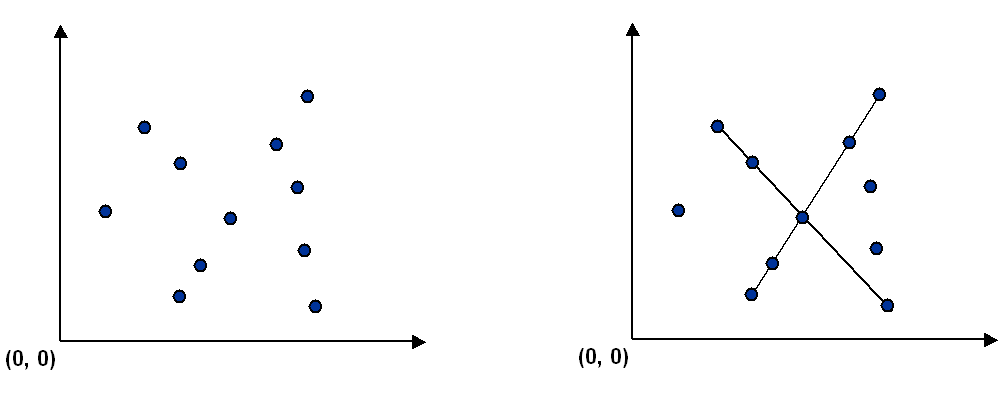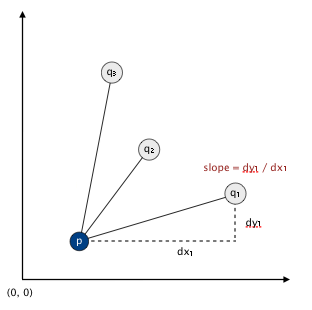此次作业[^1]需要编写一个程序来识别给定的一组点中的线段
计算机视觉包括分析视觉图像中的模式并重建产生它们的真实物体。该过程通常分为两个阶段:特征检测和模式识别。特征检测包括选择图像的重要特征;模式识别涉及到发现特征的模式。我们将研究一个特别简单的模式识别问题,涉及点和线段。这种模式识别出现在许多其他应用中,如统计数据分析。
1 问题(The problem)
给出平面上不重合的 n 个点,找出每条连接了其中 4 个或更多点的(最长的)线段
2 点的数据结构(Point data type)
2.1 数据结构(Data type)
1 | public class Point implements Comparable<Point> { |
其中 constructor、draw()、drawTo()、toString() 的代码都已给出,我们的任务是以下部分:
compareTo()方法:首先根据 y 轴坐标,其次根据 x 轴坐标比较两个点。正常情况下,当且仅当 y0 < y1,或 y0 = y1 且 x0 < x1,点 (x0,y0) 小于点 (x1,y1)slopeTo()方法:返回点 (x0,y0) 和参数点 (x1,y1)之间的斜率,公式为 *(y1 − y0) / (x1 − x0)*。水平线段的斜率为 +0;竖直线段的斜率为正无穷;退化线段(一个点与它本身之间的线段)斜率为负无穷slopeOrder()方法:返回两个参数点分别与点 (x0,y0) 之间的斜率的比较。正常情况下,当且仅当斜率 (y1 − y0) / (x1 − x0) 小于斜率 (y2 − y0) / (x2 − x0),点 (x0,y0) 小于点 (x1,y1)。对待水平线段、竖直线段、退化线段的方法与slopeTo()相同- 不要复写
equals()或hashCode()方法
2.2 极端案例(Corner cases)
为了避免整数溢出与浮点数精度引发的潜在问题,你可以假设 constructor 的参数 x 和 y 均在 0 到 32,767 之间
3 线段的数据结构(Line segment data type)
1 | public class LineSegment { |
所有 API 均已给出
4 暴力算法(Brute force)
4.1 数据结构(Data type)
写一个 BruteCollinearPoints.java,每次检测 4 个点是否共线,返回所有这样的线段。为了检测 4 个点 p、q、r、s 是否共线,检测 3 个斜率:p,q 之间、p,r 之间、p,s 之间是否全部相等
1 | public class BruteCollinearPoints { |
segments() 方法:需要包含每个含有 4 个点的线段。如果一条线段为 p→q→r→s,那么 segments() 方法需要包括线段 p→s 或 s→p(但是不同时包括这两个),而且不包括 p→r 或 q→r 这样的线段。为了简单起见,我们将不为 BruteCollinearPoints 提供任何 5 或更多点共线的输入
4.2 极端案例(Corner cases)
如果 constructor 的参数为 null 或者数组中的任意一点为 null,抛出异常 java.lang.NullPointerException
如果 constructor 的参数包含重复的点,抛出异常 java.lang.IllegalArgumentException
4.3 性能要求(Performance requirement)
最坏时间复杂度为 O(n^4)
使用内存与 (n + 返回的线段的数目)成正比
5 一个更快的,基于排序的解决方案(A faster, sorting-based solution)
5.1 算法
很明显,有比以上的暴力算法更快的解决方案。给出点 p,以下方法可以判断 p 是否是 4 点或更多点共线的集合中的点
- 将 p 当成原点
- 对于其它的点 q,计算它与点 p 之间的斜率
- 根据点与点 p 之间的斜率将点排序
- 检查在序列中是否有相邻的 3 点或更多点与点 p 之间的斜率相同,如果有,这几个点和点 p 是共线的
依次为 n 个点中的每个点执行此方法
这个算法更快是因为排序这一关键操作
写一个 FastCollinearPoints.java 实现此算法
1 | public class FastCollinearPoints { |
segments() 方法:需要包括每个 4 点或更多点贡献的最长线段。例如,如果如果有 5 点共线的线段 p→q→r→s→t,那么不要包括子线段 p→s 或 q→t
5.2 极端案例(Corner cases)
如果 constructor 的参数为 null 或者数组中的任意一点为 null,抛出异常 java.lang.NullPointerException
如果 constructor 的参数包含重复的点,抛出异常 java.lang.IllegalArgumentException
5.3 性能要求(Performance requirement)
最坏时间复杂度为 O(n^2)
使用内存与 (n + 返回的线段的数目)成正比
FastCollinearPoints 需要可以检测出 5 点或更多点共线的输入情况
6 Sample client
client 程序有一个文件名作为命令行参数;读取文件(格式如下所描述);在标准输出的每一行打印出一条程序发现的线段;在标准绘图画出线段
1 | public static void main(String[] args) { |
7 输入格式(Input format)
题目提供了几个输入样例文件(与上述 client 相配),格式如下:一个整数 n,后面跟 n 对整数 (x, y),均在 0 到 32,767 之间。以下是两个例子:
1 | % more input6.txt % more input8.txt |
8 解决方案(Solutions)
8.1 BruteCollinearPoints.java
只要遍历所有 $C_N^4$ 种可能的组合并判断是否在一条直线上即可。遍历的方法是使用嵌套的for循环(4个套在一起);因此,有一种简单的降低复杂度的方法,即先判断前三个点是否共线,如果不共线就不再找第四个点了。这样可以使大部分输入数据的时间复杂度降到O(N^3)。
8.2 FastCollinearPoints.java
避免输出子线段和重复线段:
每次得到一条线段上的所有点后,排序,当且仅当排序后第一个点是p时输出
9 代码
见 GitHub 的 repo:PrincetonAlgs4
- BruteCollinearPoints.java
- FastCollinearPoints.java
- Point.java
10 分析运行时间和占用内存(Analysis of running time and memory usage)
见分析报告
[^1]: 原文见 http://coursera.cs.princeton.edu/algs4/assignments/collinear.html
也可以从网站 http://introcs.cs.princeton.edu/java/assignments/ 找到